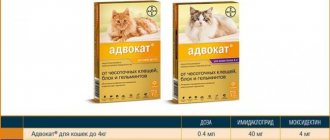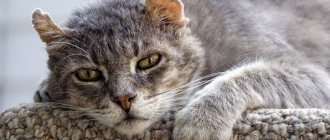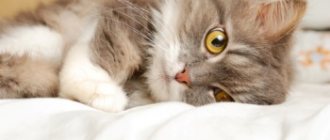Just like humans, pets often suffer from diseases that affect the visual organ. If you notice cloudiness in your pet's eye, increased tearing or swelling, you should immediately contact a qualified veterinarian for advice and help. This is due to the fact that the appearance of a cloudy film inside the eye may be evidence of the development of cataracts in a cat.
Cataracts are quite difficult to respond to therapeutic treatment methods, especially in advanced cases. As a rule, the main focus of conservative treatment is to alleviate the pet’s condition and prevent the development of complications.
With the development of cataracts, a cat may completely lose vision as a result of complete dysfunction of the lens. The very concept of cataract means clouding of a specific lens, transparent and clear under normal conditions, due to which a beam of light penetrating into the eye is refracted without distortion.
The lens in the eye is responsible for accurately transmitting images to the retina, where the brain processes information. Cloudiness of the lens provokes incorrect refraction of the light beam, the picture turns out to be very blurry, and sometimes does not reach the retina.
A cloudy lens causes a sick cat to not even see blurry objects, but only shadows. In addition, with the development of cataracts, inflammatory processes may appear against the background of a malfunction in the metabolic processes of the visual organ.
The pathological process leads to the beginning of the death of cellular structures and the breakdown of proteins located in the lens. The first signs of cataracts are not immediately noticeable, so the animal may suffer from the disease for a long time.
Causes of cataract development
Trauma is a common cause of cataracts in cats. Cloudiness of the lens surface can be caused by various mechanical damages (for example, impact, burns or foreign objects).
On a note!
The thickness of the lens in cats is 6-7 mm.
Other causes of cataracts in cats:
- Advanced age . In older cats, not only protein but also mineral metabolism is disrupted. Metabolism slows down, the amount of fluid in the lens decreases, and fat and protein deposits gradually accumulate on its surface. The result is the development of cataracts.
- Ophthalmic diseases . Often, damage to the lens develops against the background of other (primary) ophthalmological diseases. These include conjunctivitis, glaucoma, blepharitis, keratitis, entropion, etc. Without proper and timely treatment, they lead to the development of cataracts.
- Hormonal disorders . Excess weight, old age, diabetes - these and other factors directly affect the production of hormones. And some disorders, in particular a decrease in insulin synthesis, lead to increased blood sugar levels. This leads to serious consequences, including damage to the lens of the eye.
- Urolithiasis (UCD) . Unfortunately, urolithiasis is widespread among cats of different breeds. It leads to excessive deposition of phosphorus and calcium salts on the surface of the lens. This is one of the common factors leading to its partial or complete clouding.
- Other factors. Other reasons that can cause deterioration or complete loss of vision in a pet include genetic predisposition, severe poisoning (intoxication), contact with hazardous chemical compounds on the surface of the eyeball, infectious and bacterial diseases.
Prevention
You can minimize the likelihood of developing this ophthalmological disease if you adhere to a number of rules. Experts give the following recommendations in this regard:
- Avoid injuring your cat's eyes.
- After 7-8 years of age, your pet should be systematically taken to a veterinary clinic for examination, including an ophthalmological examination. If necessary, the doctor will prescribe special drops for cats.
- It is necessary to promptly begin treatment of concomitant pathologies (urolithiasis, diabetes mellitus, etc.).
- The cat's diet needs to be saturated with vitamins and minerals.
Cataracts in representatives of the cat family are a common pathology. It can develop for various reasons. To avoid complications, you need to contact a veterinary clinic when the first signs of the disease appear.
All information posted on the site is provided in accordance with the User Agreement and is not a direct instruction to action. We strongly recommend that before using any product, you must obtain a face-to-face consultation at an accredited veterinary clinic.
What cat breeds are at risk?
In 8 out of 10 cases, cataracts occur in older cats - over 8-9 years old. Animals that have crossed this age threshold often face serious illnesses, metabolic disorders, and large amounts of free radicals in the body. The result of these changes is a disruption of the structure of the eye lens.
Has your pet been diagnosed with diabetes? Be careful - this disease increases the risk of cataracts by 20%!
As for the breed predisposition of cats, brachycephalic breeds are most prone to lens clouding:
- British,
- exotic shorthair,
- Persian,
- Scottish Straight and Fold,
- Himalayan
What happens if cataracts are not treated? Are there consequences?
There are other consequences besides blindness, and in most cases they are disastrous. The fact is that when cataracts mature, the changed proteins of the lens gradually extend beyond the boundaries of the lens. Now there is a lot of protein inside the eye, and the immune system of the eye, which has never encountered such a protein before, begins to react to it as if it were foreign. Thus, inflammation (uveitis) develops inside the eye, directed against the altered lens. After some time (up to three years), cats almost always develop glaucoma (increased pressure inside the eye) due to uveitis. As a rule, such glaucoma is difficult to treat and often causes eye loss.
Signs by which you can determine clouding of the lens of the eye
Visually, at the first stage of cataract development, it is impossible to notice changes in your pet. This is due to the fact that the deterioration of visual function is compensated by well-developed hearing and sense of smell. Therefore, the symptoms of the disease are noticeable when the surface of the lens is already severely damaged.
Symptoms that may indicate the development of cataracts in an animal:
- the appearance of a small cloudy spot or film on the surface of the eye;
- the cat ceases to navigate indoors (especially in the unknown);
- the animal moves poorly;
- constantly bumps into furniture and objects;
- He practically doesn’t play because he doesn’t orient himself in space.
How is the treatment carried out?
Drug therapy
To prevent a diabetic animal from getting worse, the owner should check its blood glucose levels.
Treatment for kittens, as well as older cats, is based on what caused the disease. If cataracts are caused by infections, the veterinarian will prescribe antibacterial medications. When diabetes mellitus has become a factor, the owner will need to monitor the level of glucose in the pet’s blood, which will make it possible to slow down the processes that are observed with cataracts.
Eye drops will help fight pathology. Cats are mainly prescribed Quinax, Vitafacol and Taufon. The medication should be instilled 2 times a day, 1 drop into each visual organ. The duration of treatment is 1 month, after which they take a break for the same period and continue therapy. It is important to note that such medications do not make it possible to restore the former transparency of the lens and restore lost vision. Their mechanism of action is based on the suspension of clouding, which allows for complete loss of visual functions. Eye drops are used throughout the cat's life.
Cataracts need to be treated not only with medication. It is important to maintain the animal’s immunity, which will resist the disease. Veterinarians recommend normalizing your pet's diet. The menu should include foods that contain abundant amounts of vitamins and microelements. Food should not be fatty, spicy, or sweet. Proper nutrition will help improve metabolism, which plays a key role in the progression of the disease. In addition to food, the animal can also obtain useful components from vitamin and mineral complexes, which can be purchased at the pharmacy. The required medication will be prescribed by a physician after diagnostic measures have been carried out.
Surgical intervention
Most often, the problem of the animal is solved surgically.
Often, cataract treatment involves only medication. The operation is not performed in all veterinary clinics. However, some medical institutions provide such a service. The procedure can be carried out using several methods. Extracapsular resection is often performed. The disadvantage of this intervention is the large incision made by the surgeon. During surgery, the nucleus of the lens is removed while preserving the central and posterior capsule.
Intracapsular resection can also be performed. During this procedure, the lens is extracted together with the capsule. An equally common operation is phacoemulsification. During surgery, your veterinarian inserts an ultrasound probe through a small incision to liquefy the lens before removing it. It is considered the safest method, since there is no need for stitches after the operation. However, this method also has a drawback, which is the increased likelihood of cataract recurrence.
Types of cataracts in cats
Purchased . It occurs with age for some external (stroke, fall from a height) or internal (infection, medication) reason. Always has a progressive character, i.e. without timely contact with a veterinarian in Moscow continues to develop.
Acquired cataracts are divided into several types, depending on the factors that provoked its development:
- traumatic,
- hormonal (for example, with prolonged use of hormones),
- diabetic,
- genetic,
- senile,
- toxic.
A feature of the acquired form is that impaired metabolism can lead to its development. This means that cataracts can develop even in young cats if they are fed incorrectly, not given vitamins, or do not maintain a balanced diet.
Congenital . In this case, cataracts begin to develop at the embryonic stage. According to the researchers, this may be due to the condition of the cat (for example, if she had severe infectious diseases, this could affect the condition of the fetus).
Treatment of congenital cataracts is very difficult. In some cases, it is not possible to restore the condition of the optical lens of the eye.
What to do at home
The owner’s task is to provide the most comfortable living conditions for his pet. Like a person, a sick animal needs affection, caring attitude, and attention. A cat losing his sight will feel much more confident if he feels supported by people.
If your pet has undergone surgery, it will be followed by a long rehabilitation period. Recovery includes the use of antibacterial drugs and ophthalmic drops that relieve corneal swelling and pain.
To prevent the cat from scratching its eyes and causing infection, a special collar is put on it. The condition of the operated cat is assessed by a veterinarian: examinations are carried out monthly for six months.
The cat's diet, both during treatment and after surgery, should be balanced in composition and enriched with vitamins.
Stages of cataract development
- Initial . Cloudiness occurs at the edges of the eye. The cat is able to see objects and the environment around itself, but not quite clearly.
- Immature . The middle zone of the lens gradually becomes cloudy. The animal still distinguishes objects around it, but its vision drops quite significantly.
- Mature . The entire surface of the lens becomes cloudy. As a result, the cat is unable to distinguish objects or navigate in an unfamiliar room.
- Overripe . The cat completely stops seeing. She does not distinguish whether it is dark or light around her. The lens is completely destroyed. It breaks down into fibers.
The sooner you contact a good veterinary clinic in Moscow, the greater the chance of returning your cat to full vision!
Care and recovery
The result of surgery depends not only on the surgeon, but also on the cat owner, who must follow all the veterinarian’s recommendations during the rehabilitation period. The animal will need to be given antibacterial medications, as well as drops that relieve pain and swelling of the cornea. The cat will need to wear a special collar that will prevent him from scratching his visual organs. In addition, the owner needs to regularly take the animal for a veterinary examination.
Diagnosis and treatment
Only a veterinarian can make a diagnosis. The only method used for this is visual inspection. The specialist will conduct an instrumental examination, ask a few questions to the animal owner and check the eyesight.
This is necessary to make a diagnosis, determine the possible causes of lens clouding, determine the stage of development of cataracts and its type - unilateral (covers only one eye) or bilateral (both eyes are damaged at once).
For the treatment of cataracts the following is used:
- Drug therapy . Prescribed at the initial stage of cataract development, if surgical intervention is not possible. The veterinarian prescribes eye drops that restore and improve metabolic processes in the lens of the eye. At the same time, a healthy diet and the absence of physical overload and stress are recommended.
- Surgical intervention . The modern method is phacoemulsification. This is cataract removal using an ultrasound probe. An artificial lens is placed in place of the removed lens. To replace it, special syringes are used - injectors or tweezers. Surgery remains the only method to completely get rid of cataracts in a cat’s eye!
Remember that the cat's health, first of all, depends on your attentiveness and care. If you notice that your pet’s vision has deteriorated or cloudiness has appeared on the surface of the eye, then immediately seek professional veterinary help in Moscow!
International Veterinary Center for Reproduction and Artificial Insemination of Small Animals
CATARACTS IN CATS. DIAGNOSIS AND TREATMENT OF CATARACTS.
Perepechaev K.A. PhD, ophthalmologist, microsurgeon
Center for Veterinary Ophthalmology of Dr. Perepechaev.
www.9265231897.ru www.cataract-dog.ru
1. WHAT IS CATARACT
Cataract is a clouding of the lens (the lens is a transparent optical biological lens located inside the eye and focuses the image on the retina ) . Cataract is a pathological process in which the lens loses its transparency completely or partially, thereby disrupting the flow of light to the retina and deteriorating visual functions. From a biochemical point of view, lens opacification is the process of irreversible transformation of transparent soluble lens proteins into opaque and insoluble ones. Depending on the size/volume of the cataract (the degree of lens opacity), vision may deteriorate from slight to complete loss of visual function ( Fig. 1, 2, VIDEO 1, VIDEO 2 ).
VIDEO 1: Mature cataract in a 7-year-old cat
VIDEO 2: Cataracts in an Abyssinian kitten
2. PATHOLOGICAL EFFECTS OF CATARACTS IN CATS
2.1.Deterioration of vision
As the lens becomes cloudy, vision gradually deteriorates. The cloudy lens absorbs more and more light, which does not reach the retina, which prevents the formation of a clear image of the object in question. With a completely cloudy, opaque lens, the eye is only able to distinguish light from darkness and distinguish the movement of large objects against a background of bright light ( VIDEO 3 ). With completely opaque, congenital cataracts, if the retina initially does not receive the amount of light necessary for normal functioning, then the visual centers of the brain do not develop. Thus, a kitten with a congenital opaque cataract, if not operated on within the first 4-6 months of life, will likely remain blind for life. A similar situation arises in older cats: for example, if an animal becomes blind due to age-related cataracts at the age of 9-10 years, and the cataract is not operated on for 1-2 years, then against the background of natural age-related degenerative processes, the retina and visual centers of the brain may stop functioning normally, the situation will become irreversible, and vision will not be restored, even after a successful operation.
VIDEO 3: Visual impairment due to cataracts
CONCLUSIONS: To preserve and restore visual functions, cataracts should always be operated on as early as possible. Waiting tactics are pointless and only cause harm. Waiting for cataracts to “ripen” is absolute stupidity.
2.2. Development of intraocular inflammation
During the process of cataract formation, the lens substance (lens proteins) begins to break down (degenerate) and gradually leaks through the lens capsule and into the intraocular fluid. Lens proteins are perceived by the immune system of the eye as foreign, and provoke severe inflammation of the choroid (lens-induced or phacolytic uveitis ) ( Fig. 3, 4 ).
The inflammation of the choroid that has begun can no longer stop, constantly intensifies (as the lens is destroyed) and ultimately leads to severe intraocular inflammation - endophthalmitis or severe secondary ( phacogenic ) glaucoma (Fig. 5) .
At these stages, the only way to save a sick animal is removal or intraocular prosthetics of the diseased eye ( intraocular prosthetics in dogs and cats (IOP) Article.)
The intraocular prosthetics (IOP) technique has an undoubted advantage over eye removal (enucleation). IOP is a significantly less traumatic operation, faster, and with less blood loss. This is especially important when performing surgery on cats with severe pain and poor general condition. The operation gives a good cosmetic effect, however, it cannot restore visual functions (Fig. 6, 7) .
The time of onset of lens-induced uveitis varies greatly, depending on the age of the animal and the cause of the cataract. In young animals, especially in kittens 3-6 months of age, intraocular inflammation begins almost simultaneously with the onset of cataract formation. In older animals, intraocular inflammation against the background of cataracts can develop slowly and imperceptibly, but if obvious clinical signs of uveitis become visible, we can assume that the eye is already lost... Rapid and powerful lens-induced uveitis develops with penetrating trauma to the sclera and cornea (classic injuries cat's claw) with damage to the lens. In this case, large fragments of the destroyed lens enter the intraocular fluid, which causes an immediate inflammatory process ( phacoclastic uveitis ). The surgical prognosis for uveitis is always very poor. Even a well-performed operation and subsequent intensive therapy, in some cases, still does not make it possible to “extinguish” the inflammation of the choroid that has already begun.
CONCLUSIONS: Cataract surgery should be performed as early as possible, before the development of lens-induced uveitis. Waiting tactics are pointless and only cause harm. In case of inflammation of the choroid, only the operating surgeon can and should determine the chances of preserving the eye and visual functions and prescribe preoperative preparation.
2.3. Lens luxation
Luxation of the lens is its displacement relative to its normal position when the ligaments that hold it are ruptured (more details on: Website about cataracts in animals ) ( VIDEO 4 ).
VIDEO 4: Lens luxation in a 3-year-old British cat
Typically, luxation occurs in cats due to rupture of the ciliary ligaments holding the lens, against the background of inflammation of the choroid, or against the background of age-related changes in very old animals (over 11-13 years old). At the same time, the transparent (non-cataract) lens is more often displaced ( VIDEO 5 ).
VIDEO 5: Lens luxation in a 13-year-old cat
However, during the formation of cataracts, degenerative changes occur not only in the substance of the lens, but also in its capsule and ligamentous apparatus. Lens-induced uveitis, which develops with cataracts, further accelerates the process of destruction of the ligaments that support the lens. Thus, the likelihood of lens luxation, after the formation of a cataract, is even more likely ( Fig. 8, 9 ).
CONCLUSIONS : Luxation of the lens always entails an increase in intraocular pressure (glaucoma) or the development of severe intraocular inflammation with destruction of the vitreous body and retina. Any of these processes will eventually lead to the loss of the eyeball. Timely surgical treatment of cataracts allows you to prevent the development of these processes and preserve the eye and normal vision.
2.4. Destruction of the capsular bag, swelling of the cataract
As we mentioned above, cataracts in young kittens (from 2-3 to 6 months) often develop extremely aggressively. Active disintegration of the lens substance occurs, accompanied by degeneration and destruction of the posterior (thinner) capsule of the lens. When the posterior capsule is perforated, there is a direct, volumetric loss of the lens substance into the intraocular fluid, which leads to acute intraocular inflammation and loss of the eye ( Fig. 10, 11 ).
In some kittens, on the contrary, liquefaction or “resorption” of the cataract occurs, in which the liquid degenerated substance of the lens leaks through the capsule into the intraocular fluid. The volume of the lens is significantly reduced, its transparency may even be partially restored, however, wrinkling and gluing of the anterior and posterior capsules occurs, powerful capsular fibrosis develops (formation of secondary cataracts) and chronic inflammation of the choroid continues. All these processes irreversibly and inevitably lead to the destruction and loss of not only visual functions, but also the eye itself.
In some rare cases, active absorption of intraocular fluid by the cataract lens is possible. At the same time, the volume of the lens increases sharply, the normal outflow of intraocular fluid is blocked, and acute severe glaucoma develops. This condition can be accompanied by severe pain and threaten the kitten’s life.
CONCLUSIONS : The only way to prevent possible severe complications associated with the destruction of cataracts is the speedy and high-quality operation to remove them.
3. CAUSES OF CATARACTS IN CATS
Unlike dogs, whose main type of cataract is primary bilateral genetically determined cataract , in cats, there is currently no reliable evidence of the genetic nature of cataracts, and genetic tests for cataracts have not been developed. There are works by individual researchers on the genetic inheritance of cataracts in Himalayan and British cats, with a simple autosomal recessive type of inheritance, however, only a few cases have been statistically described.
Let's look at the main causes of cataracts in cats:
- Congenital cataracts . They can be unilateral or bilateral, usually diagnosed in kittens at the age of 3-6 months, although they are already present at the time of birth. The exact cause is unknown (genetic or congenital abnormalities, intrauterine viral infections, etc.). Congenital eye abnormalities, such as abnormalities of the fetal vasculature (Persistent Pupillary Membrane (PPM); Persistent Hyperplastic Tynic Vasculosa Lentis/Primary Vitreous (PHPV/PHTVL), can also cause cataract formation ( VIDEO 6, VIDEO 7 ).
VIDEO 6: Thin central cataract in a kitten
VIDEO 7: Persistent pupillary membrane in a mongrel cat
- Secondary “ inflammatory” cataract occurs against the background of inflammation of the choroid , due to the effect of toxic inflammatory products and abnormal immune reactions on the lens. It is extremely widespread due to the extremely high degree of carriage and disease of chronic viral infections of cats (CVI: leukemia, immunodeficiency, feline coronavirus) ( VIDEO 8 ). “Inflammatory” cataracts are usually diagnosed in relatively young animals, at the age of 6 months – 2.5 years, but it can also be congenital. “Inflammatory” cataracts can also occur in adult or elderly cats with long-term severe inflammation of the choroid ( infectious uveitis ).
VIDEO 8: Bilateral cataracts in a British kitten with CVI:
- Traumatic cataracts . They arise as a consequence of through or non-through severe injuries to the eyeball. Often found in outdoor cats ( VIDEO 9 ).
- Metabolic cataracts occur against the background of metabolic disorders. Rarely, diabetic cataracts can occur in cats, and cataracts can also form in small kittens due to a deficiency of the amino acid arginine. More often, metabolic cataracts occur in kittens of large predatory cats (tiger, spotted and black leopard, cheetah). This almost always happens when hand-feeding kittens of large predators, and the use of numerous additives to milk formulas and milk replacers ( Fig. 12, 13 ).
- Secondary cataracts due to other eye diseases , for example, the development of cataracts due to glaucoma, lens luxation, severe intraocular hemorrhage, tumor compression, etc.
- Senile or age-related cataracts do not occur in “pure form” in cats. Even in 17-19 year old animals, the lens, despite the high degree of compaction (age-related nuclear sclerosis), remains quite transparent. The true cause of “age-related” cataracts, in the vast majority of cases, is one of the processes listed above.
4. APPEARANCE OF CATARACTS IN CATS
Cataracts in cats, as in other species of animals, are characterized by a very diverse appearance, from small dots and stripes against the background of a generally transparent lens, to completely opaque, cloudy white cataracts that occupy the entire volume of the lens.
It is important to understand that the appearance of a cataract does not always indicate the stage of the pathological process and its danger to the eye. In young animals, especially in kittens under 6 months, the cataract may not reach the stage of complete opacification at all; the inflammatory process and decay of the cataract will destroy the eye before the cataract has time to “mature” ( Fig. 14 ).
And, conversely, in elderly or old cats (over 13-14 years old), the lens may have a cloudy yellow tint due to age-related changes, however, it does not pose a danger to the eye and has sufficient optical transparency to preserve visual functions. The so-called “inflammatory” cataracts (see above) may represent only minor focal opacities of the lens, however, they pose an enormous danger due to the developing intraocular inflammation. In the case of luxation (separation, displacement) of the lens, despite the extreme severity and danger of this process, the displaced lens is often completely transparent and at the initial stage does not have any areas of opacification ( Fig. 15 a, b ).
CONCLUSIONS : For a non-specialist (pet owner or general practitioner), the appearance of a cataract does not provide any information about the stage of the process or its danger. Any externally visible clouding of the lens must be assessed as potentially dangerous, and urgently contact a veterinary ophthalmologist for a full diagnosis and treatment ( Fig. 16 a, b ).
4. TREATMENT OF CATARACTS IN CATS
Modern human and animal medicine today has the only way to treat cataracts - surgery . The purpose of surgery is to remove the cloudy lens and, if possible, implant an optical element in place of the removed lens - an intraocular lens (IOL) or, as it is also called, an artificial lens.
Perhaps in the future, medicine will learn to reverse the process of transformation and aging of lens cells, and will be able, with the help of special procedures, to return the lens to its former transparency, perhaps... But, today, there are no other methods of treating cataracts other than surgery. EXISTS.
No “special” drops, ointments, vitamins, laser or other procedures, acupuncture, massage, or even “magic” glasses (made using modern nanotechnology) can cure or slow down the progression of cataracts. If you are offered to treat cataracts in any way other than surgery, you should know that this is either illiteracy or fraud.
Many veterinarians, unfortunately, when diagnosing cataracts in cats or dogs, recommend “preparatory treatment” to the owners until the cataract “ripes.” Conscientious owners go to these doctors, use prescribed medications, are examined, observed, waste their time and money, in fact, losing precious time and the chance for a successful operation...
only the doctor who will operate on you prescribes preoperative therapy and observes the patient before the operation If a doctor does not operate on cataracts himself, you cannot be treated or observed by him . This “non-operating doctor” does not have the necessary knowledge and experience, he actually does not know or know how to do anything, he simply, under a plausible pretext, makes money from you. It's sad, but it's true.
In modern surgical treatment of cataracts, various methods of lens removal are used: phacoemulsification - phaco; destruction of the lens by an intense flow of liquid; various techniques for mechanical removal of the lens nucleus (extra and intracapsular extraction); femto-phaco, etc. The technique is selected based on the condition of the lens, its density, capsule strength, the presence of secondary pathological processes inside the eye, potential visual functions, visual acuity in a healthy eye, the presence of systemic diseases, etc.
The technique of lens removal, in itself, is not of fundamental importance; any of the above methods gives excellent results, even in the most difficult cases, if the operation is carried out in a timely manner and with high quality ( VIDEO 10 ).
Implantation of an intraocular lens (IOL) after removal of the lens is a rather complex technical action, and in fact, represents a separate stage of the operation. A particularly difficult task is IOL implantation for traumatic cataracts, cataracts in very small kittens, complicated cataracts, cataracts associated with inflammation of the choroid (“inflammatory” or uveal cataracts), etc. IOL implantation for the treatment of cataracts has its pros and cons ( Table 1 ).
Table 1. Pros and cons of intraocular lens (IOL) implantation after cataract surgery in cats.
The postoperative period, which includes wearing a protective collar and the use of special eye medications, is as important as the operation itself. Without high-quality, attentive care on the part of the owner, compliance with all medical recommendations, and regular preventive medical examinations, it is impossible to obtain a good result.
5. OUR APPROACH TO TREATING CATARACTS IN CATS
Our center has been engaged in eye microsurgery in animals for more than 20 years, and we are the absolute leaders in the number of successful cataract surgeries in cats. The combination of the most modern diagnostic and treatment equipment, with the highest qualifications of operating specialists, allows us to achieve a successful result of 95-98% in planned operations for the treatment of cataracts in cats. , all cats operated by us restore their visual functions and maintain good vision for many years. In our center, ALL cataract operations are performed directly by Perepechaev K.A. PhD, microsurgeon, head of the center, one of the leading Russian veterinary ophthalmologists, a specialist with extensive practical experience and the highest qualifications ( VIDEO 11 ).
VIDEO 11: Complex, congenital cataracts in cats with RRM
We use unique video diagnostic equipment (our own development), which allows us to evaluate in detail and qualitatively all the features of cataracts in a particular patient. We develop, design and manufacture our own models of unique intraocular lenses for dogs and cats . Today, we implant IOL models that are ideal for each patient . No veterinary center in the world has such capabilities .
Thanks to the advanced technology for cataract removal, high-quality performance of the operation itself, thoughtful and carefully planned postoperative care and treatment, our patients do NOT NEED to take injections after surgery, carry out painful manipulations, apply drops 6-7 times a day, or constantly come to see a doctor , remove stitches under anesthesia, etc., etc. We not only perform operations well and get excellent results, we make sure that postoperative treatment for a beloved cat is as convenient as possible for the owner, and comfortable and easily tolerated for the cat itself. In addition, we provide surgical patients with round-the-clock (24 hours a day) support: the opportunity, at any time, to contact the operating surgeon or anesthesiologist and therapist, the opportunity to come to an emergency appointment with your attending physician any day.
6. CONCLUSION
Cataracts in cats are a serious eye pathology that has become more and more common lately. Only timely and high-quality surgical treatment of cataracts can save the eye and restore vision in a sick animal. In our center, modern microsurgical technologies, combined with extensive experience, allow us to successfully treat cataracts. The success rate of cataract treatment in cats during elective surgery in our center is 95-98%. Of fundamental importance for the successful treatment of cataracts in cats is, of course, timely seeking qualified ophthalmological care. The earlier the operation is performed, the easier it is, and the better the postoperative results and visual functions of the operated animal.
The article was published on 02/06/2019 and posted on the websites: www.pet-reproduction.com www.9265231897.ru and www.cataract-dog.ru
Author of the article: Perepechaev Konstantin Andreevich . All rights reserved.
Any reproduction of the article in part or in whole, as well as drawings or photographs of the article, without a link to the sites www.pet-reproduction.com www.9265231897.ru and www.cataract-dog.ru and an indication of the author of the article is PROHIBITED .
Similar materials
- Small intestinal foreign body in a cat
- Reproductive problems in cats
- Chronic viral infections of cats
- Calendar of expected births in cats.
- Life before birth: cats.
What tests need to be taken before lens replacement surgery? Which doctors should I go to?
Before the operation we require without fail:
- Complete blood count + ESR + platelets. Valid for 10 days.
- Blood sugar. Valid for 10 days.
- RW (syphilis). Valid for 1 month.
- Hepatitis B and C. Expiration date: 3 months.
- HIV. Valid for 3 months.
- Fluorography (x-ray of the lungs). Valid for 1 year.
- ECG. Valid for 1 month.
- Dentist consultation. Valid for 1 month.
- ENT consultation. Valid for 1 month.10.
- Consultation with a therapist. Valid for 1 month.
- If you have a history of diabetes mellitus, consult an endocrinologist. Valid for 1 month.
Why so many tests?
How are patients monitored?
Each patient after surgery is assigned individual postoperative observation. On average, you will need to see a doctor 4-5 times. But in some cases it’s more – it all depends on the specific case. Visits to the doctor are scheduled once a week. It is highly recommended not to skip the post-operative examination prescribed by your doctor. If the patient nevertheless missed or did not show up at the appointed time, you need to understand that responsibility for the consequences falls on him. In this case, we record that the patient did not show up for the consultation at the appointed time, make a note on the card, and call to find out the reason for the absence.











